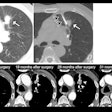Dear Digital X-ray Insider,
Breast cancer survivors are at elevated risk for spinal abnormalities, such as scoliosis, due to adverse effects of treatment on bone health. Pain, limited upper limb motion, and the influence of breast weight on an individual's center of gravity may trigger adaptive changes in posture after surgery, studies suggest.
However, most studies to elucidate the issue have used photogrammetry or Moire topography, and results have been inconsistent, according to a group in South Korea. They recently sought clinical evidence of postural changes in these patients two years after surgery on whole-spine anteroposterior standing x-rays. Check out the story on the research in this edition's Insider Exclusive.
We were shocked by a recent article by Harvard University science historians. They discussed how Black patients historically received higher doses of radiation than white patients -- and that this "racialization of the x-ray" persisted in the U.S. until the late 1960s.
In a significant article in artificial intelligence (AI) research, colleagues at Stanford University and New York University questioned the validity of established techniques meant to show users how radiology AI algorithms arrive at their findings.
We offered a few stories touching on medicolegal issues. In one, researchers suggested that providing patient decision aids could reduce lawsuits in interventional radiology. On the crime beat, we covered the news that the president of a portable x-ray firm in Ohio was sentenced to 15 years in prison for defrauding Medicare and Medicaid of $2 million for services the company didn't provide.
Portable chest x-ray imaging was central in two stories related to improving image quality and workflow. A group in New York called for more support for radiologic technologists following a study that found quality failures may be present in nearly half of images acquired at their hospital. Meanwhile, Pakistani researchers found that on-call residents matched attending radiologists diagnosing emergency cases of pneumothorax.
Speaking of improving workflow, a group in Australia found that giving referring physicians feedback on their exam request patterns reduced unnecessary musculoskeletal imaging order rates by about 10%.
Finally, a dynamic x-ray technique showed promising results for visualizing hyperinflation of the lungs in patients with chronic obstructive pulmonary disease.
That's all for now. Be sure to check back often for more news in your Digital X-Ray Community.




















